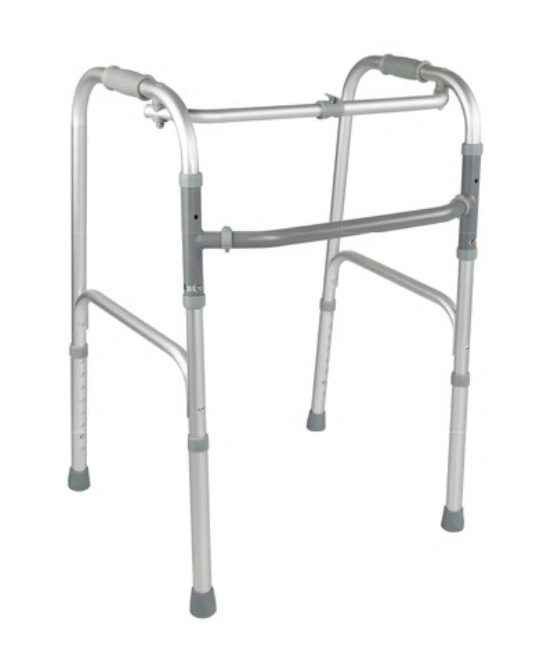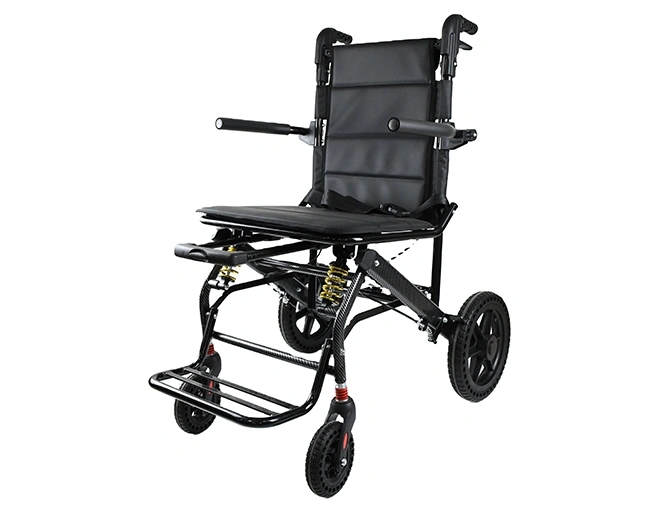Elegir el tamaño adecuado de caminador para discapacitados para sus necesidades de movilidad
Tiempo : Oct 23, 2025 Vista : 1.308
Caminadores con discapacidad Funcionan como herramientas esenciales de movilidad que ayudan a las personas con restricciones de movimiento, incluidos los ancianos. La selección correcta del tamaño de un andador determina tanto la seguridad como la comodidad del usuario y la postura adecuada y la simplicidad operativa. Las personas que necesitan caminadores para la recuperación quirúrgica o problemas de movilidad relacionados con la edad deben entender las dimensiones del caminador porque determina su capacidad de moverse libremente.

¿Los caminantes con discapacidad vienen en diferentes tamaños?
Los caminadores para discapacitados existen en múltiples dimensiones que apoyan a los usuarios que varían en altura y peso y tienen diferentes requisitos físicos.
Variaciones en las dimensiones de Walker
Los principales factores que determinan las dimensiones del andador incluyen el rango de altura y la distancia entre las manijas y la altura completa del bastidor. Un andador con excesiva altura pondrá presión en los hombros, pero un andador que es demasiado corto llevará a una postura doblada. La anchura de un andador determina su idoneidad para espacios interiores porque los andadores estrechos se ajustan bien en áreas estrechas, pero los andadores más amplios proporcionan una mejor estabilidad cuando se usan al aire libre.
Tipos de caminantes en función del tamaño
Los caminantes estándar sirven como la categoría principal que incluye caminantes junior y caminantes bariátricos. Los caminantes estándar cumplen con las necesidades de los adultos típicos, pero los caminantes juniores proporcionan apoyo para usuarios más cortos, incluidos los niños, y los caminantes bariátricos tienen marcos reforzados para usuarios más pesados. La gama de productos incluye caminantes con marcos amplios y diseños plegables que mejoran la movilidad.
Factores a considerar al elegir el tamaño del caminador
La selección de un andador requiere más que la medición de altura porque necesita tener en cuenta la estructura corporal completa y las actividades diarias del usuario.
Altura del usuario y longitud del brazo
La altura del mango debe coincidir con la posición del pliegue de la muñeca cuando los usuarios están de pie con los brazos relajados por sus lados. El ángulo correcto del codo para su uso debe estar entre 15 y 30 grados. La alineación del mango afecta la salud de las articulaciones porque el posicionamiento incorrecto puede causar dolor en las articulaciones y crear una posición de trabajo inestable.
Capacidad de peso y resistencia del marco
La selección de un andador requiere un modelo que distribuya el peso del usuario correctamente mientras mantiene la estabilidad. La silla de ruedas tiene una capacidad de peso máxima de 100 kg. Los usuarios que excedan los 100 kg de peso deben usar el producto con precaución o buscar asistencia del fabricante para soluciones personalizadas. Es necesario respetar los límites de peso de los caminantes porque superarlos conduce a averías estructurales que dan lugar a condiciones de funcionamiento peligrosas.
Uso interior vs. exterior
Los zapatos para caminar en interiores tienen un diseño más estrecho con suelas de goma que proporcionan tracción en superficies planas. Los zapatos para caminar al aire libre tienen ruedas más grandes que manejan superficies ásperas y marcos más amplios que proporcionan una mejor estabilidad.
Características de ajustabilidad en caminantes modernos
Existen ayudas de movilidad modernas para proporcionar soluciones adaptables que sirvan a diferentes tipos de usuarios.
Alturas de manija ajustables
La mayoría de los caminantes para discapacitados incluyen patas telescópicas que permiten a los usuarios cambiar las alturas del mango a través de botones cargados con muelles o mecanismos de bloqueo. Las muletas de asistencia médica con diseño ligero y función de ajuste de altura representan el enfoque moderno para el desarrollo de productos centrados en el usuario.
Marcos plegables y opciones de portabilidad
La capacidad de plegar el andador sirve como una característica vital porque permite a los usuarios llevar su ayuda para caminar cuando necesitan moverse o almacenarla. Ayudas para caminar: Los dispositivos de asistencia para caminar de seguridad para personas mayores vienen con marcos plegables que los hacen adecuados para viajar y áreas de estar compactas.

El papel de los accesorios en la mejora del ajuste y la funcionalidad
Los caminantes se vuelven más cómodos de usar, mientras que su ajuste y usabilidad mejoran cuando los usuarios agregan accesorios.
Accesorios de asiento y características de almacenamiento
Algunos caminantes de estilo rollator proporcionan asientos incorporados para los caminantes que necesitan descansar durante períodos prolongados de caminata porque se cansan rápidamente. Los usuarios pueden beneficiarse de compartimentos de almacenamiento que incluyen cestas y bolsas para llevar objetos personales mientras mantienen las manos libres.
Personalización de agarres de mano, ruedas y frenos
Los agarres ergonómicos ayudan a los usuarios a evitar la tensión de la muñeca cuando trabajan por períodos prolongados. Las ruedas delanteras giratorias funcionan como ruedas personalizadas que mejoran la movilidad y el sistema de frenado avanzado ayuda a los usuarios a mantener el control cuando navegan por pendientes y terrenos desiguales.
Errores comunes al elegir un tamaño de caminante
La selección de una ayuda de movilidad se hace más fácil cuando se mantiene alejado de los errores típicos que la gente suele cometer.
Elegir solo en función del precio
La selección de modelos más baratos por razones de presupuesto puede conducir a perderse características importantes como la ajustabilidad y la durabilidad. Xunyu Médico diseña sus dispositivos de asistencia para personas mayores con un enfoque en la comodidad y la durabilidad y la confianza del usuario.
Ignorar la condición física o el entorno del usuario
La falta de considerar las restricciones físicas como la artritis junto con las restricciones ambientales como las puertas limitadas da como resultado sistemas que son difíciles de usar o peligrosos de operar.
No consultar con un profesional de la salud
Los proveedores de atención médica evalúan los patrones de marcha para determinar los tipos de caminadores adecuados para las necesidades individuales, lo que minimiza la necesidad de errores de prueba y error.
Cómo medirse para el ajuste correcto del caminante
La medición correcta de su andador proporcionará comodidad y seguridad durante su primer uso.
Guía paso a paso para el tamaño adecuado en casa
-
Póngase de pie usando su calzado habitual.
-
Deja que tus brazos cuelguen naturalmente en tus costados.
-
Medir desde el piso hasta el pliegue de la muñeca.
-
Esta medición debe coincidir con la altura del caminante’ s manijas.
-
Asegúrese de que los codos se doblen a unos 15-30 grados al agarrar las manijas.
Cuándo buscar asistencia profesional de un terapeuta o especialista
Antes de comprar cualquier ayuda para la movilidad debe consultar a un terapeuta ocupacional o fisioterapeuta si experimenta problemas de equilibrio o problemas de postura o tiene complicaciones posquirúrgicas o condiciones ortopédicas complejas.
Xunyu Medical: un proveedor confiable de ayudas para la movilidad
La empresa Foshan Xunyu Medical Technology Co., Ltd. opera desde la ciudad de Danzao en el distrito de Nanhai de la ciudad de Foshan dentro de la provincia de Guangdong. La empresa desarrolla dispositivos de asistencia para personas mayores para simplificar sus actividades diarias y mejorar su seguridad durante las tareas de cuidado.
Xunyu Medical estableció su negocio para centrarse en el desarrollo tecnológico que dio lugar a mejoras en el diseño de productos que cumplen con los requisitos de los usuarios mayores. La empresa ofrece una gama de productos incluyendo muletas sillas de ruedas reposabrazos de inodoro y ayudas especializadas para caminar diseñadas para usuarios de edad avanzada en diversos entornos.
El representante de la compañía declaró que su misión se centra en permitir la independencia de los ancianos a través de productos fiables que muestran una cuidadosa consideración del diseño.
Xunyu Medical diseña sus dispositivos de asistencia para ancianos para proporcionar comodidad al tiempo que garantiza la durabilidad y la confianza del usuario. La compañía mantiene operaciones en todo el mundo mediante la entrega de soluciones de movilidad fiables a las principales plataformas de comercio electrónico en Europa y América del Norte, Asia-Pacífico y otros mercados internacionales.

Conclusión
Elegir el tamaño correcto para un caminante con discapacidad es muy importante. Lo mantiene seguro, acogedor y capaz de moverse fácilmente. Piensa en cosas como lo alto que eres, cuánto pesas y dónde usarás el caminador, dentro o fuera. Estos te ayudan a encontrar un andador que funcione justo para ti. Los caminantes con partes ajustables, como ajustes de altura, los hacen encajar mejor. Algunos andadores se plegan, lo que es ideal para llevar o almacenar, mientras que otros vienen con extras, como asientos o bolsas para tus cosas. Esto agrega más comodidad y uso. Para evitar errores, mide con cuidado. El asesoramiento de un médico o experto también ayuda. Ellos pueden guiarlo a la mejor opción. Con empresas confiables como Xunyu Medical que ofrecen ayudas para caminar fuertes y fáciles de usar, puede elegir un andador que lo ayude a mantenerse independiente. Hace la vida diaria mejor y más fácil.
Preguntas frecuentes:
Q1: ¿Cuál es la altura correcta para un caminante con discapacidad?
R: La altura del mango debe coincidir con el pliegue de la muñeca cuando está de pie recto con los brazos colgados a los lados, lo que permite una curvatura del codo de 15 a 30 grados para el uso adecuado.
Q2: ¿Por qué no se recomienda usar un andador con dimensiones incorrectas?
R: Un andador de tamaño incorrecto causa mala postura, incomodidad en los hombros y dolor de espalda al alcanzar o inclinarse, lo que conduce a inestabilidad, mala maniobrabilidad y aumento del riesgo de caída.
Q3: ¿Son todos los caminantes con discapacidad ajustables?
R: La mayoría de los caminantes modernos tienen patas ajustables para ajustar las alturas del mango en función del tamaño del cuerpo, pero algunos carecen de personalización completa como plegabilidad o accesorios del asiento, por lo que elija en función de sus necesidades.


